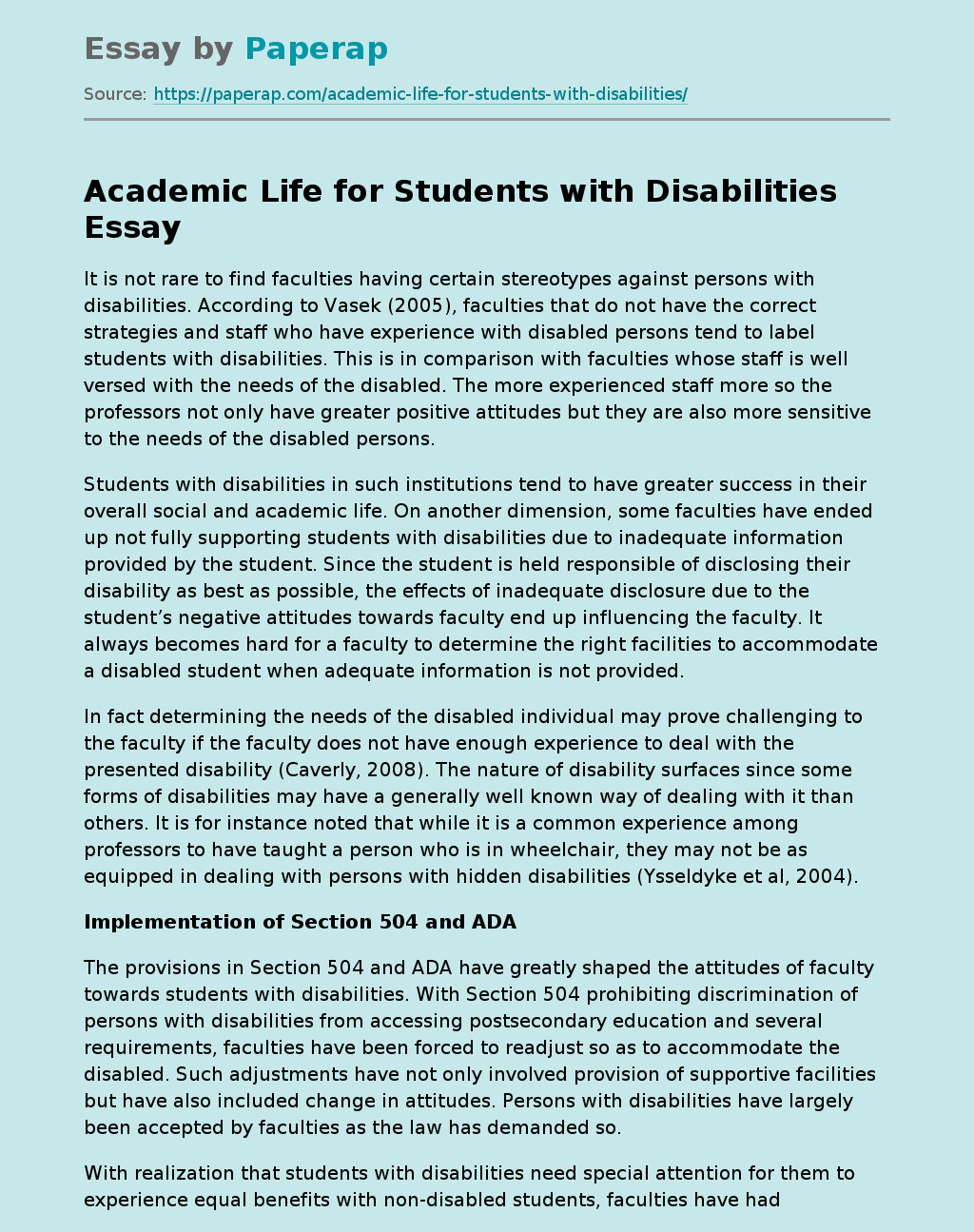Academic Life for Students with Disabilities
The following sample essay on Academic Life for Students with Disabilities tells about information provided by the student.
It is not rare to find faculties having certain stereotypes against persons with disabilities. According to Vasek (2005), faculties that do not have the correct strategies and staff who have experience with disabled persons tend to label students with disabilities. This is in comparison with faculties whose staff is well versed with the needs of the disabled. The more experienced staff more so the professors not only have greater positive attitudes but they are also more sensitive to the needs of the disabled persons.
Students with disabilities in such institutions tend to have greater success in their overall social and academic life. On another dimension, some faculties have ended up not fully supporting students with disabilities due to inadequate information provided by the student. Since the student is held responsible of disclosing their disability as best as possible, the effects of inadequate disclosure due to the student’s negative attitudes towards faculty end up influencing the faculty.
It always becomes hard for a faculty to determine the right facilities to accommodate a disabled student when adequate information is not provided.
In fact determining the needs of the disabled individual may prove challenging to the faculty if the faculty does not have enough experience to deal with the presented disability (Caverly, 2008). The nature of disability surfaces since some forms of disabilities may have a generally well known way of dealing with it than others. It is for instance noted that while it is a common experience among professors to have taught a person who is in wheelchair, they may not be as equipped in dealing with persons with hidden disabilities (Ysseldyke et al, 2004).
The provisions in Section 504 and ADA have greatly shaped the attitudes of faculty towards students with disabilities. With Section 504 prohibiting discrimination of persons with disabilities from accessing postsecondary education and several requirements, faculties have been forced to readjust so as to accommodate the disabled. Such adjustments have not only involved provision of supportive facilities but have also included change in attitudes. Persons with disabilities have largely been accepted by faculties as the law has demanded so.
With realization that students with disabilities need special attention for them to experience equal benefits with non-disabled students, faculties have had to provide for auxiliary services that are necessary. According to Saunders (2007), faculties have had to provide appropriate accommodation services for the disabled students as per the requirements of the law. It has also been noted that despite the much acceptability of the inclusion of the disabled in the institutions of higher education, the private sector in general does not seem to view this move very positively.
Training faculty members on the ways to effectively handle students with disabilities in order to benefit the student to the maximum has been a move created by Section 504 and ADA. The willingness to accommodate students with disabilities has been shown to vary greatly in faculties depending on several variables. According to Rao (2004), while faculties (professors in specific) have shown great acceptance of some forms of accommodations for students with disabilities, the willingness to provide such assistance differs depending on the types of facilities required.
For instance, there seems to be a greater acceptability to offer learning aids such as taped lectures extended time for assignments as compared to allowing the student with disability to do special assignments in addition to the normal ones. Poor understanding and implementation of the requirements of Section 504 and ADA has created relatively negative attitudes towards persons with disabilities which have ended up in legal battles (DePoy & Gitlin, 2005). Faculties may for instance have difficulties with dealing with sensitive disability issues that the student may present.
While it is the obligation of the faculty to provide necessary support to the disabled student, the faculty is still supposed to work within its capacity. Balancing the need to have the student’s needs catered for and catering for overall learning needs for other students becomes tough for faculties and they may tend to develop negativity on accommodating the disabled. Accommodating the needs of persons with disabilities requires extra efforts and resources. A professor for instance may be required to set extra time to prepare taped notes and other auxiliary aids for the disabled persons.
The faculty in itself may require extra resources and infrastructure to ensure smooth learning for the disabled students. Whereas this may be received negatively by some facilities, some faculties appreciate accommodating the disabled. Even in cases where the resources have been provided, it is the sentiments of some faculties that students with disabilities sometimes end up not being served effectively (Buskist & Davis, 2006). This implies that some faculties do not fully embrace and appreciate the need to have the disabled persons treated equally in the institutions of higher education.
Academic Life for Students with Disabilities. (2019, Dec 05). Retrieved from https://paperap.com/academic-life-for-students-with-disabilities/

